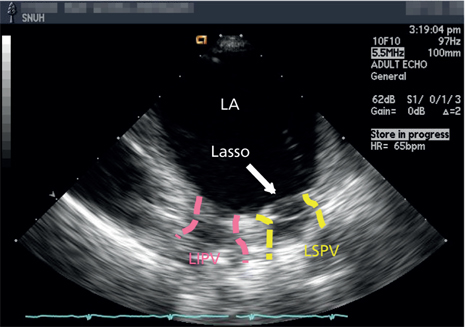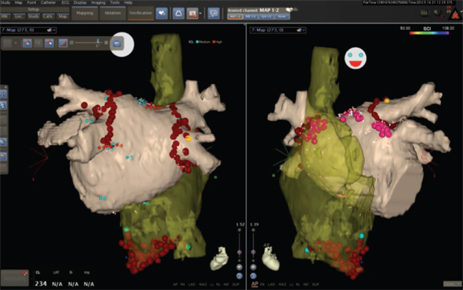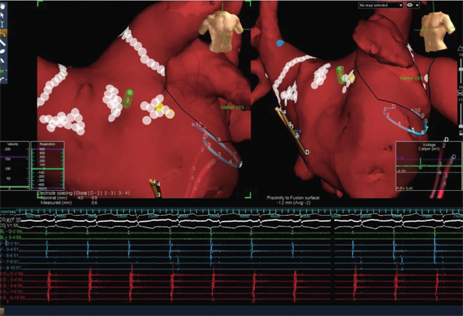J Korean Med Assoc.
2016 May;59(5):374-378. 10.5124/jkma.2016.59.5.374.
Catheter ablation for treatment of tachyarrhythmia
- Affiliations
-
- 1Department of Internal Medicine, Seoul National University College of Medicine, Seoul, Korea. seil@snu.ac.kr
- KMID: 2420636
- DOI: http://doi.org/10.5124/jkma.2016.59.5.374
Abstract
- Catheter ablation is one of the major treatment options for patients with arrhythmia. It has been widely used since radiofrequency energy was adopted as a power source. Technical progress has resulted in better outcomes, better efficiency, and safer procedures. However, mechanisms of some forms of arrhythmia such as atrial fibrillation have not been fully elucidated in order to obtain a more favorable success rate. Therefore, progress in the basic research field to understand the mechanisms and substrates of arrhythmia as well as technical progress is essential for overcoming current obstacles in this therapeutic method.
Keyword
MeSH Terms
Figure
Reference
-
1. Scheinman MM, Morady F, Hess DS, Gonzalez R. Catheter-induced ablation of the atrioventricular junction to control refractory supraventricular arrhythmias. JAMA. 1982; 248:851–855.
Article2. Huang SK, Bharati S, Graham AR, Lev M, Marcus FI, Odell RC. Closed chest catheter desiccation of the atrioventricular junction using radiofrequency energy: a new method of catheter ablation. J Am Coll Cardiol. 1987; 9:349–358.
Article3. Jackman WM, Wang XZ, Friday KJ, Roman CA, Moulton KP, Beckman KJ, McClelland JH, Twidale N, Hazlitt HA, Prior MI, Margolis PD, Calame JD, Overholt ED, Lazzara R. Catheter ablation of accessory atrioventricular pathways (Wolff-Parkinson-White syndrome) by radiofrequency current. N Engl J Med. 1991; 324:1605–1611.
Article4. Calkins H, Sousa J, el-Atassi R, Rosenheck S, de Buitleir M, Kou WH, Kadish AH, Langberg JJ, Morady F. Diagnosis and cure of the Wolff-Parkinson-White syndrome or paroxysmal supraventricular tachycardias during a single electrophysiologic test. N Engl J Med. 1991; 324:1612–1618.
Article5. Haines DE. The biophysics of radiofrequency catheter ablation in the heart: the importance of temperature monitoring. Pacing Clin Electrophysiol. 1993; 16(3 Pt 2):586–591.
Article6. Oh S, Kilicaslan F, Zhang Y, Wazni O, Mazgalev TN, Natale A, Marrouche NF. Avoiding microbubbles formation dur-ing radiofrequency left atrial ablation versus continuous microbubbles formation and standard radiofrequency ablation protocols: comparison of energy profiles and chronic lesion characteristics. J Cardiovasc Electrophysiol. 2006; 17:72–77.
Article7. Lee C, Choi EK, Kong HJ, Choy YB, Kim HC, Oh S. Generating radiofrequency ablation lesions using magnetically coupled bipolar catheters. Pacing Clin Electrophysiol. 2011; 34:934–938.
Article8. Haissaguerre M, Jais P, Shah DC, Takahashi A, Hocini M, Quiniou G, Garrigue S, Le Mouroux A, Le Metayer P, Clementy J. Spontaneous initiation of atrial fibrillation by ectopic beats originating in the pulmonary veins. N Engl J Med. 1998; 339:659–666.
Article9. January CT, Wann LS, Alpert JS, Calkins H, Cigarroa JE, Cleveland JC Jr, Conti JB, Ellinor PT, Ezekowitz MD, Field ME, Murray KT, Sacco RL, Stevenson WG, Tchou PJ, Tracy CM, Yancy CW. ACC/AHA Task Force Members. 2014 AHA/ACC/HRS guideline for the management of patients with atrial fibrillation: a report of the American College of Cardiology/American Heart Association Task Force on practice guidelines and the Heart Rhythm Society. Circulation. 2014; 130:e199–e267.10. Hoyt H, Bhonsale A, Chilukuri K, Alhumaid F, Needleman M, Edwards D, Govil A, Nazarian S, Cheng A, Henrikson CA, Sinha S, Marine JE, Berger R, Calkins H, Spragg DD. Complications arising from catheter ablation of atrial fibrillation: temporal trends and predictors. Heart Rhythm. 2011; 8:1869–1874.
Article11. Piccini JP, Sinner MF, Greiner MA, Hammill BG, Fontes JD, Daubert JP, Ellinor PT, Hernandez AF, Walkey AJ, Heckbert SR, Benjamin EJ, Curtis LH. Outcomes of medicare beneficiaries undergoing catheter ablation for atrial fibrillation. Circulation. 2012; 126:2200–2207.
Article12. Shah RU, Freeman JV, Shilane D, Wang PJ, Go AS, Hlatky MA. Procedural complications, rehospitalizations, and repeat procedures after catheter ablation for atrial fibrillation. J Am Coll Cardiol. 2012; 59:143–149.
Article
- Full Text Links
- Actions
-
Cited
- CITED
-
- Close
- Share
- Similar articles
-
- Successful Treatment of Tachycardia-induced Cardiomyopathy with Radiofrequency Catheter Ablation
- Radiofreqeuncy Catheter Ablation for Tachyarrhythmia
- Invasive strategies for rhythm control of atrial fibrillation: a narrative review
- Safety and Efficacy of Radiofrequency Catheter Ablation in Treatment of Tachyarrhythmia in Elderly Patients
- Effectiveness of the Early Staged Hybrid Approach for Treatment of Symptomatic Atrial Fibrillation: the Electrophysiology Study Could Be Deferred?




